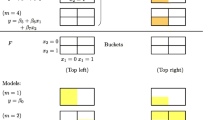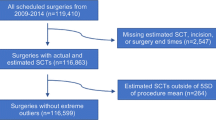Abstract
For effective operating room (OR) planning, surgery duration estimation is critical. Overestimation leads to underutilization of expensive hospital resources (e.g., OR time) whereas underestimation leads to overtime and high waiting times for the patients. In this paper, we consider a particular estimation method currently in use and using additional temporal, operational, and staff-related factors provide a statistical model to adjust these estimates for higher accuracy.
The results show that our method increases the accuracy of the estimates, in particular by reducing large errors. For the 8093 cases we have in our data, our model decreases the mean absolute deviation of the currently used scheduled duration (42.65 ± 0.59 minutes) by 1.98 ± 0.28 minutes. For the cases with large negative errors, however, the decrease in the mean absolute deviation is 20.35 ± 0.74 minutes (with a respective increase of 0.89 ± 0.66 minutes in large positive errors). We find that not only operational and temporal factors, but also medical staff and team experience related factors (such as number of nurses and the frequency of the medical team working together) could be used to improve the currently used estimates. Finally, we conclude that one could further improve these predictions by combining our model with other good prediction models proposed in the literature. Specifically, one could decrease the mean absolute deviation of 39.98 ± 0.58 minutes obtained via the method of Dexter et al (Anesth Analg 117(1):204–209, 2013) by 1.02 ± 0.21 minutes by combining our method with theirs.





Similar content being viewed by others
References
Bach F (2008) Bolasso: model consistent lasso estimation through the bootstrap. Proceedings of the 25th international conference on machine learning, pp 33–40
Ballantyne GH, Ewing D, Capella RF, Capella JF, Davis D, Schmidt HJ, Wasielewski A, Davies RJ (2005) The learning curve measured by operating times for laparoscopic and open gastric bypass: roles of surgeon’s experience,institutional experience, body mass index and fellowship training. Obes Surg 15(2):172–182
Bell R, Koren Y (2007) Scalable collaborative filtering with jointly derived neighborhood interpolation weights.Proceedings of the seventh IEEE international conference on data mining , pp 43– 52
Cassera MA, Zheng B, Martinec DV, Dunst CM, Swanstrm LL (2009) Surgical time independently affected by surgical team size. Am J Surg 198(2):216–22
Combes C, Meskens N, Rivat C, Vandamme JP (2008) Using a KDD process to forecast the duration of surgery. Int J Prod Econ 112(1):279–293
Dexter EU, Dexter F, Masursky D, Kasprowicz KA (2010) Prospective trial of thoracic and spine surgeons updating of their estimated case durations at the start of cases. Anesth Analg 110(4):1164–68
Dexter F, Traub RD, Qian F (1999) Comparison of statistical methods to predict the time to complete a series of surgical cases. J Clin Monit Comput 15:45–51
Dexter F, Ledolter J (2005) Bayesian prediction bounds and comparisons of operating room times even for procedures with few or no historic data. Anesthesiology 103(6):1259– 67
Dexter F, Macario A, Ledolter J (2007) Identification of systematic underestimation (bias) of case durations during case scheduling would not markedly reduce overutilized operating room time. J Clin Anesth 19(3):198–203
Dexter F, Dexter EU, Masursky D, Nussmeier NA (2008) Systematic review of general thoracic surgery articles to identify predictors of operating room case durations. Anesth Analg 106(4):1232–41
Dexter F, Dexter EU, Ledolter J (2010) Influence of procedure classification on process variability and parameter uncertainty of surgical case durations. Anesth Analg 110(4):1155– 63
Dexter F, Ledolter J, Tiwari V, Epstein RH (2013) Value of a scheduled duration quantified in terms of equivalent numbers of historical cases. Anesth Analg 117(1):204–209
Eijkemans MJ, van Houdenhoven M, Nguyen T, Boersma E, Steyerberg EW, Kazemier G (2010) Predicting the unpredictable:a new prediction model for operating room times using individual characteristics and the surgeon’s estimate. Anesthesiology 112(1):41–49
ElBardissi AW, Duclos A, Rawn JD, Orgill DP, Carty MJ (2013) Cumulative team experience matters more than individual surgeon experience in cardiac surgery. J Thorac Cardiovasc Surg 145(2):328–333
Gillespie BM, Chaboyer W, Fairweather N (2012) Factors that influence the expected length of operation: results of a prospective study. BMJ Qual Saf 21(1):3–12
Joustra P, Meester R, van Ophem H (2013) Can statisticians beat surgeons at the planning of operations? Empir Econ 44(3):1697–1718
Kayis E, Wang H, Patel M, Jain S, Ramamurthi RJ, Santos C, Singhal S, Suermondt J, Sylvester K (2012) Improving prediction of surgery duration using operational and temporal factors. Proceedings of the American Medical Informatics Association 2012 Annual Symposium, pp 456–462
Macario A, Dexter F (1999) Estimating the duration of a case when the surgeon has not recently scheduled the procedure at the surgical suite. Anesth Analg 89(5):1241–5
Larsson A (2013) The accuracy of surgery time estimations. Prod Plan Control 24(10-11):891-902
Li Y, Zhang S, Baugh RF, Huang JZ (2010) Predicting surgical case durations using ill-conditioned cpt code matrix. IIE Trans 42(2):121–135
Pisano GP, Bohmer RMJ, Edmondson AC (2001) Organizational differences in rates of learning: evidence from the adoption of minimally invasive cardiac surgery. Manag Sci 47(6):752–768
Spangler WE, Strum DP, Vargas LG, May JH (2004) Estimating procedure times for surgeries by determining location parameters for the lognormal model. Health Care Manag Sci 7(2):97– 104
Stepaniak PS, Heij C, Mannaerts GH, de Quelerij M, de Vries G (2009) Modeling procedure and surgical times for current procedural terminology-anesthesia-surgeon combinations and evaluation in terms of case-duration prediction and operating room efficiency: a multicenter study. Anesth Analg 109(4):1232– 45
Stepaniak PS, Heij C, De Vries G (2010) Modeling and prediction of surgical procedure times. Statistica Neerlandica 64(1):1–18
Strum DP, Sampson AR, May JH, Vargas LG (2000) Surgeon and type of anesthesia predict variability, in surgical procedure times. Anesthesiology 92(5):1454–66
Strum DP, May JH, Sampson AR, Vargas LG, Spangler WE (2003) Estimating times of surgeries with two component procedures: comparison of the lognormal and normal models. Anesthesiology 98(1):232–40
Wooldridge JM (2003) Introductory econometrics: a modern approach. South-Western, Mason
Wright IH, Kooperberg C, Bonar BA, Bashein G (1996) Statistical modeling to predict elective surgery time. Anesthesiology 85(6):1235–45
Zou H, Hastie T (2005) Regularization and variable selection via the elastic net. J R Statist Soc B 67(2):301–320
Acknowledgements
The authors thank a superb team of anonymous reviewers and editors for helpful suggestions that improved the content and structure of the paper. This research was funded in part by the Hewlett-Packard Company.
Author information
Authors and Affiliations
Corresponding author
Rights and permissions
About this article
Cite this article
Kayış, E., Khaniyev, T.T., Suermondt, J. et al. A robust estimation model for surgery durations with temporal, operational, and surgery team effects. Health Care Manag Sci 18, 222–233 (2015). https://doi.org/10.1007/s10729-014-9309-8
Received:
Accepted:
Published:
Issue Date:
DOI: https://doi.org/10.1007/s10729-014-9309-8




